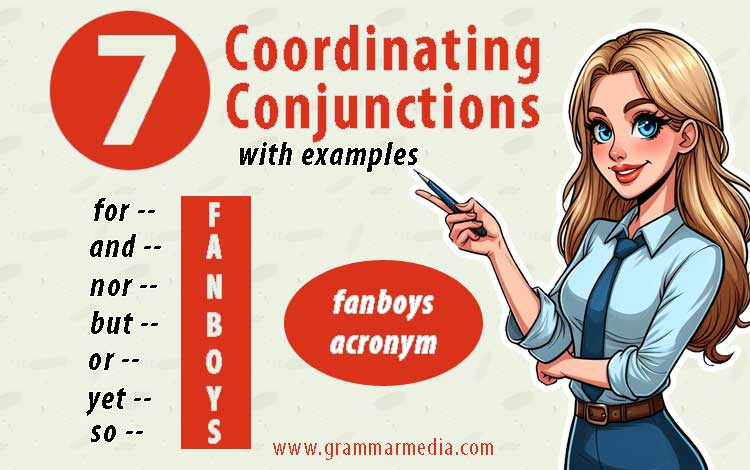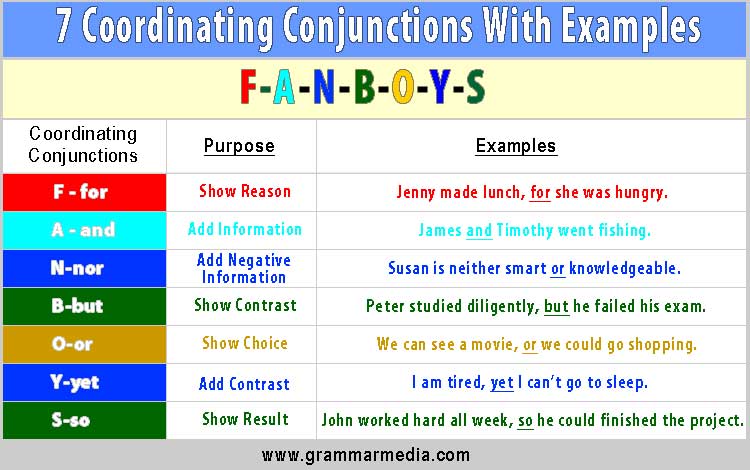It is often said that conjunctions are the glue that holds words, phrases, and clauses together. Coordinate conjunctions connect words, phrases, and clauses of equal value.
So what are the 7 coordinating conjunctions? The 7 coordinating conjunctions are: for, and, nor, but, or, yet, so. These 7 coordinating conjunctions can be remembered by using the acronym FANBOYS.

What is a Coordinating Conjunctions?
Coordinating Conjunctions join two or more words, phrases, and clauses of equal value to each other. In other words, coordinating conjunctions are used to give equal emphasis to a pair of words, phrases, or clauses.
Since there are only seven (7) coordinating conjunctions, it is a good idea to memorize these coordinating conjunctions using the acronym FANBOYS.

7 Coordinating Conjunctions With Examples
1. Coordinating Conjunction – FOR
Definition: The coordinating conjunction “for” expresses or indicates a causal relationship between two similar ideas in a sentence. It is used like the word “because” to show reason. In other words, it expresses or indicates the reason for an action.
For Example:
- Peter went to work early, for the boss wanted him to finish the project as soon as possible.
- They avoided travelling on the highway, for the traffic had congested due to roadworks.
- Jenny decided to take a nap, for she was feeling tired from a late night out.
- The football team trained diligently all summer, for they wanted to win the competition.
- James prepared dinner, for his girlfriend was coming over.
Some Tips:
You need to use a comma when coordinating conjunctions (namely for) to connect clauses of equal value.
- Rachel wanted to go for a walk in the park, for the weather was beautiful.
- James saved his money, for he wanted to buy a new car.
In both sentences, the comma signals a slight pause, and they show the reason or cause that follows.
The first sentence, “Rachel wanted to go for a walk in the park” stands alone as a complete thought, and the second part explains why she wanted to walk in the park.
The second sentence, “James saved his money” stands alone as a complete thought, and the second part gives the reason why he wanted to save his money.
2. Coordinating Conjunction – AND
Definition: The coordinating conjunction “and” is used to link two ideas together, and it is used between the second-to-last and last item in a series.
When the coordinating conjunction “and” is used to link two ideas together, it adds information of equal value to the information provided in the first clause (see examples below).
For Example:
- Peter cleaned the garage, and James swept the floor. (linking two ideas)
- Rachel loves peanuts, chocolate, and vanilla ice cream. (a series of items)
- Amma sang and danced all night at her birthday party. (linking two ideas)
- David is wise, smart, and knowledgeable. (a series of items)
- Timothy washed the dishes, and Rebekah dried them. (linking two ideas)
- Jonathan fishing, hunting, and sailing over the long weekend. (a series of items)
Some Tips:
When using “and” to connect two independent clauses (complete sentences that can stand alone), it is preceded by a comma as seen in the examples below.
- Wendy went to the store, and she purchased a new dress.
- Terry cleaned his room, and he made his bed.
When using “and” to connect two words or ideas, you don’t need to use a comma as seen in the examples below.
- Peter and John are best of friends.
- David loves reading interesting and informative books.
When using “and” in a series of items, it is usually beneficial to use a comma as seen in the examples below.
- Our national flag is red, white, and blue.
- Timothy collects stamps, old coins, and rare books.
NOTE: There is debate about using a comma (known as the Oxford Comma) before “and” in a series of items. I have written an article relating to this debate regarding the Oxford Comma.
3. Coordinating Conjunction “NOR”
Definition: The coordinating conjunction “nor” is used to connect two or more negative statements in a sentence. It indicates that the second statement is not true or it does not happen.
Furthermore, the coordinating conjunction “nor” helps maintain balance when listing negative statements as seen in the examples below.
For Example:
- James doesn’t like coffee, nor does he drink tea.
- Timothy could find neither the keys for the car nor the spare set.
- Rachel didn’t study for her exams, nor did she review her notes.
- The thief neither apologized nor explained his criminal behavior.
- The game didn’t start on time, nor did it reach the people’s expectation.
Some Tips:
When using “nor” to join two independent clauses, a comma should precede it as seen in the examples below.
- Peter did not attend the celebrations, nor did he send a representative in his place.
- The meeting did’t cover all the issues, nor did it provide opportunity for questions.
When using “nor” to connect two short independent clauses, you might choose to omit the comma in order for a smoother flow as seen in the examples below.
- Peter neither called nor informed me that he was injured.
- Jonathan neither laughed nor smiled when he heard the news.
4. Coordinating Conjunction – BUT
Definition: The coordinating conjunction “but” introduces a contradiction or tension between two clauses or ideas. Also, it can signal an exception to what has been stated previously. Furthermore, it can indicate a limitation or restriction on what has been previously said.
For Example:
- Jonathan worked hard all day, but he still didn’t finish the project. (contrast)
- Matthew usually likes spicy foods, but that dish was too hot for him. (exception)
- Mark is a smart student, but he struggles with calculus. (limitation)
- Jenny promised to be there on time, but she arrived late as usual. (contrast)
- Peter usually prefers tea, but he decided to have coffee instead. (exception)
- Harry is very intellignet, but he struggles with social interaction. (limitation)
Some Tips:
When joining independent clauses with “but” to from a compound sentence, you will need to use a comma before “but” to separate the clauses as seen in the examples below.
- David wanted to go to work, but his recovery from surgery took longer than expected.
- Luke was a bright person, but he struggled to relate to other people.
When joining short independent clauses that are closely related and the contrast between them doesn’t need a pause for clarity, you might choose to omit the comma as seen in the examples below.
- William loves to read but rarely finds the time.
- Wendy’s kind but can be overly sensitive.
HELPFUL HINT: When using coordinating conjunctions to join two independent clauses, a comma is typically used before it.
5. Coordinating Conjunction – OR
Definition: The coordinating conjunction “or” is used to indicate a difference between two equal options. It can show a choice between two option, a choice where only one option is vaild, or it can join two statments where only one is true.
For Example:
- You can have vanilla or chocolate ice-cream. (choice between two options)
- You can have either tea or coffee. (one option is valid)
- You can either go to the game or stay home. (two statements but only one is true)
- Would you like to have chicken for dinner or beef? (choice between two options)
- You must choose the red dress or blue dress for the party. (one option is valid)
- The package will arrive on Wednesday or the day after. (two statements but only one is true)
Some Tips:
When using “or” to join two elements in a sentence, make sure they are parallel in structure as seen in the examples below.
- You can either swim in the pool or relax in sun. (two verbs in parallel)
- You can either have tea or coffee. (two nouns in parallel)
When using “or” to join independent clauses, a comma is typically used before it.
- You can go to the store now, or you can wait until tomorrow.
- We can go to the movies tonight, or we can go tomorrow afternoon during our dinner break.
6. Coordinating Conjunction – YET
Definition: The coordinating conjunction “yet” introduces a new idea that contradicts and limits the main clause. It also indicates continuation of an unexpected and surprising outcomes.
For Example:
- The preacher seemed confident, yet his voice trembled with nerves. (contrast)
- Timothy showed great potential, yet his experience was lacking. (limited)
- Peter was a skilled driver, yet he got into accidents frequently. (surprising outcome)
- The survivor of the acident appeared calm, yet his heart raced with anxiety. (contrast)
- The new plans were feasible, yet they came with certain constraints. (limited)
- Rachel had a brillant academic record, yet she struggled to find employment in her field of study. (surprising outcome)
Some Tips:
When using “yet” to join two independent clauses, a comma is usually used before it.
- The weather was sunny, yet it was somewhat chilly outside.
- Timothy was very popular with people, yet he remained quite humble.
7. Coordinating Conjunction – SO
Definition: The coordinating conjunction “so” is used to express consequences or results. It indicates that the second clause is the result or effect of the first clause.
For Example:
- David forgot to set his alarm, so he overslept and missed the bus for school.
- Rebekah’s car ran out of gas, so she need to call for assistance>
- Peter spend all his money on a new computer, so now he can’t afford to go on holidays.
- Paul and Wendy arrived late to the game, so they missed the pre-game entertainment.
- Jonathan forgot to water the plants, so they wilted and die.
Some Tips:
When using “so” to join independent clauses, use a comma before it.
- Peter said, “I’m tired, so I’m going to bed.”
- Susan forgot her umbrella, so she got drenched in the rain.
7 Coordinating Conjunctions Chart
| COORDINATING CONJUNCTION | ||
|---|---|---|
| F–For | Expresses Reason | Peter went to the dentist, for he had a tooth ache. |
| A–And | Adds Information | He ran to the rescue, and he saved his friends. |
| N–Nor | Adds Negative Information | The evil man wasn’t arrested nor detained for his crimes. |
| B–But | Indicates Contrast | Peter sang brillantly, but he failed to win the contest. |
| O–Or | Expresses Choice | You can have either tea or coffee. |
| Y–Yet | Adds Contrast | David was a great preacher, yet he didn’t get the opportunities to showcase his talent. |
| S–SO | Expresses Results | The farmer ploughed the field, so he could plant his crop. |